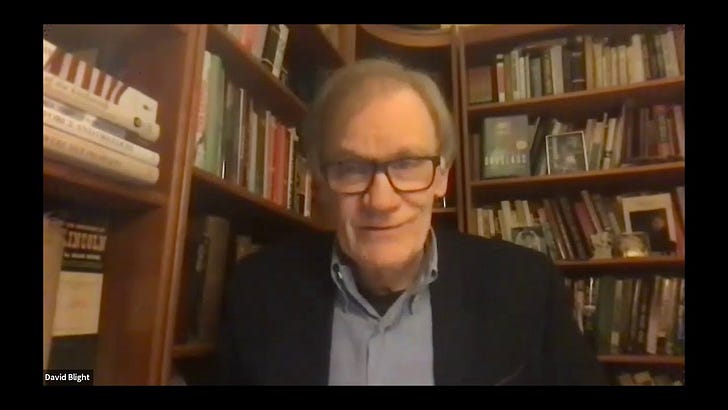Confederate "Heritage" Month 2023, April 25: David Blight on history and memory in Lost Causes past and present
“Deflections and evasions, careful remembering and necessary forgetting, and embittered and irreconcilable versions of experience are all the stuff of historical memory." - David Blight, 20011
Historian David Blight in this presentation called “How the Aftermath of the Civil War Helps Us Understand Trumpism”2 presents us with distinctions between history and memory in the American understanding of the Civil War and Reconstruction.
Blight distinguishes here between history and memory. Broadly speaking, in this context history is what happened and what historian research, write, and teach about it. Memory is how groups of people think about their collective past and the emotional and ideological implications they attach to it.
In the video, he calls out several types of Civil War/Reconstruction memory that he identified in his 2001 book Race and Reunion: The Civil War in American Memory:
Reconciliationist: This view he sees based on the unprecedented and still-unsurpassed level of carnage during the Civil War, which of course fell on both sides, though most of the fighting was on the territory of the Confederacy.
Emancipationist: Emphasizes the defeat of slavery and the resultant expansion of democracy, the Reconstruction “experiment” that he describes as a “political revolution,” one he clearly sees as a postive development.
White Supremacist: This version is the fantasy world in which the Civil War had nothing to do with slavery and was largely the result of Northern fanaticism. While it had enough political logic to make it tragically successful as an ideology, it was rather bizarrely disconnected from the lived experience and the public narrative on both sies during the Civil War itself and the period leading up to it.
He mentions a fourth view that other others have suggested and which he basically accepts in the video as a useful addition, a Union Victory version. He describes this as a kind of truncated version of the Emancipationist view in which the North took pride in ending slavery but did not embrace the democratic reforms of Reconstruction and took no interest in racial reconciliation.
Blight talks in the video from February 2021, the month after the January 6 insurrection, about how he sees elements of a potential Lost Cause narrative developing among today's Trumpistas, a topic he addressed in a Politico interview about the same time. There he calls attention to a moment in the January 6 attack on the Capitol involving the image of the man I call the Evil Spirit of American History:
[Zack Stanton:] One of the lingering images of that the insurrection is the photo of a man holding a Confederate flag outside the Senate chamber while walking past a painting of abolitionist Sen. Charles Sumner.
[Blight:] Yeah, with a painting of John Calhoun right behind him."3
Blight's 2001 book describes at some length the official and civil-society activities that generated the Lost Cause narrative after the Civil War, including the still-continuing public disputes over public monuments. And he discusses the role of monuments in this video lecture, as well.
One of the more intriguing comments he makes in the lecture is that reconciliation - a balance between justice and healing - always means that something is lost.
Blight in Politico stresses that the further development of the Trumpist outlook involves transmuting the "lost cause" of the past "into a victory story." And he frames the current general understanding of the Civil War era in this way:
We’re drawn back to the Civil War because its great issues—especially the great issues of Reconstruction—are still with us: the nature of federalism; the relationship between the states and the federal government; what government means in people’s lives; how centralized government should be; how energetic, how interventionist government should be; and race and racism. The Civil War and Reconstruction are the country’s first great racial reckoning, and it brought about tremendous changes in law and in life—and then, of course, it brought about a counterrevolution that defeated much of it. [my emphasis]
And he makes the following sobering reflection there on how to combat a Lost Cause ideological narrative:
It’s like stomping on flowers that come back the next spring or something. I think you can only do what you have the tools to do. In journalism, that means to keep finding the truth, writing about it, and spreading it as wide as you can. In writing and teaching history, you find the evidence, you write good narratives, and you write in a way to reach the broadest public as best you can.
I don’t think we’re going to do it by having groups of neighbors get together at churches and just talk to one another. You’re not going to get neighbors to get back together. So I don’t know, except that we just have to keep doing what each of us knows how to do: persuade with our professions by reaching out to people as widely as possible.
I also believe this firmly: In all the work I’ve done on the Civil War and public memory, the central thing I’ve learned is that you can’t have healing without some balance with justice. You have to have both. The justice has to be just as real as any kind of healing. I hope it’s not all olive branches with no clenched fist, because it’s got to be both. [my emphasis]
Blight, David (2001): Race and Reunion: The Civil War in American Memory. Cambridge MA & London: Belknap Press.
Blight, David (2021): How the Aftermath of the Civil War Helps Us Understand Trumpism with David W. Blight. GuilfordFreeLibrary YouTube channel 02/13/2021. (Accessed: 2023-18-04).
Stanton, Zack (2021) How Trumpism Is Becoming America’s New “Lost Cause” (interview with David Blight). Politico Magazine 01/21/2021. <https://www.politico.com/news/magazine/2021/01/21/trump-civil-war-reconstruction-biden-lost-cause-461161> (Accessed: 2023-18-04).


